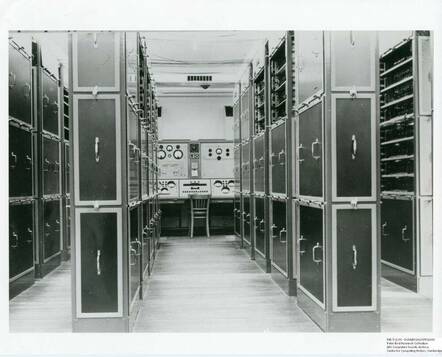This article is more than 1 year old
Think that spreadsheet in your company's accounts dept is old? 70 years ago, LEO ran the first business app
Mods to the design of EDSAC were 'considerable' says boffin
Seventy years ago this week, LEO, the world's first computer for business, ran one of the first enterprise applications after several experimental test runs.
Built for British catering and tea shop giant J Lyons, the Lyons Electronic Office, dubbed LEO, took inspiration from the Cambridge EDSAC, which ran its first programs in 1949.
The LEO, however, was business-focused, and was initially used for the firm's bakery valuation jobs (which were run weekly) before expanding its reach into more of J Lyons' back-office functions, such as payroll.
Records published by the Centre for Computing History show the first successful program ran in three parts, starting on 28 November 1951. The final part was completed on 30 November, 1951.
The notebooks of Ernest Lenaerts, (available in scanned form on the Centre for Computing History's site), who worked on the computer at the time, document the excitement of the successful run of the first part with "P1 completed today without any hitches!" on 28 November, 1951.
Seven decades on, and there remains that fizz of excitement when a bit of code does what it should without firing errors at the console.
Lisa McGerty, LEO project manager at the Centre for Computing History, told The Register: "LEO has, in past accounts of the history of computing, sometimes been dismissed merely as a copy of EDSAC, but it really wasn't.
"Lyons had to make considerable modifications to the design of EDSAC to make it suitable for commercial applications."
The Lyons company had taken a keen interest in the EDSAC project and made contributions to it in the run-up to the execution of its first program in 1949. With the concept proven, Lyons kicked off development of LEO, expanding on the EDSAC design.
As for the beast itself, around 2,500 square feet of floor space at Cadby Hall on London's Hammersmith Road was devoted to its construction. Fast paper tape readers were used to feed data into the machine; its memory (ultrasonic delay-line memory was based on tanks of mercury) came to nearly 9kB (greater than EDSAC) and, of course, this was in the days of vacuum tubes.
We'll dispense with the usual then versus now comparisons; suffice to say pretty much any modern IT kit could run rings around LEO.
However, that very first business program, designed for bakery valuation jobs, ushered in an industry in which many IT workers remain gainfully employed today. LEO itself would go on to take on more tasks, eventually attracting the attention of agencies such as the UK's Met Office and kicking off the concept of outsourcing as Lyons began running calculations for other companies.
As for that original LEO, it would be followed by the LEO II and III, and LEO Computers would eventually be merged into the English Electric Company (EEC). EEC itself would be folded into ICL as the 1960s drew to a close.
And J Lyons? Despite the efficiencies introduced by its pioneering use of computers in a business setting, it settled into a lengthy decline. The Science Museum of London notes that the last of the LEOs, owned by the Post Office and used for calculating telephone bills, went out of service in 1981, the same year that the last of the Lyons teashops closed.
While efforts are underway at The National Museum of Computing to recreate a working EDSAC, very little hardware remains of the LEO today. "Certainly nothing working," said McGerty.
Instead, the intent of the LEO project at the Centre for Computing History is to recreate the long-gone LEO I room at the teashop mogul's Cadby Hall headquarters in Hammersmith , London, with the aid of virtual reality.
- A history of personal computing in 20 objects part 1
- When civilisation ends, a Xenix box will be running a long-forgotten job somewhere
- Happy 60th birthday, video games. Thank William Higinbotham for your misspent evenings
- The field at the centre of the universe: Cambridge's outdoor pulsar pusher
"That way," she said, "we can build in things from our archive, as well as pieces of video/audio, to bring LEO alive, rather than simply displaying the hardware."
VR might not be to everyone's taste, however, a short film has been made replete with contributions from those involved in the project. "It certainly was a challenge to make the film during the pandemic," McGerty said, "especially given the age of the remaining pioneers."
"But being able to continue with the project because we could use technologies that are descendants of LEO's first steps into business computing was also a very fitting thing."
The short film is due to premiere on YouTube on 30 November. In the meantime, please join us in raising a glass (or slice of cake) to those pioneers responsible for firing up the first business application 70 years ago. ®

